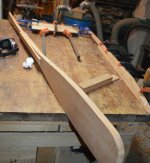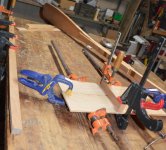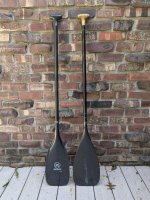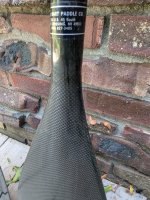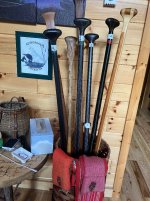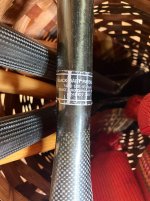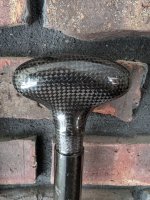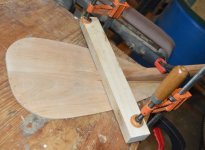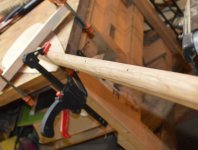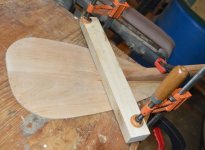I took a little test paddle Thursday to check some of my outfitting before taking a canoe-camp trip.
One of the things that became apparent is that I need at least one more paddle - my current paddles are good when seated and moving at a moderate pace. They are not so useful when kneeling and trying to paddle at higher cadence. So, after a dive into the woodpile, a new paddle begins to take shape:
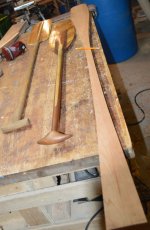
The two finished paddles on the bench are the most used out of my current collection, and are being used as a comparison reference.
Both existing paddles are the same overall length - 48"-50", but have very different handling properties.
Thoughts and feedback on what I might want to watch for or telling my why I'm insane - especially when at this early stage - are welcome.
One of the things that became apparent is that I need at least one more paddle - my current paddles are good when seated and moving at a moderate pace. They are not so useful when kneeling and trying to paddle at higher cadence. So, after a dive into the woodpile, a new paddle begins to take shape:

The two finished paddles on the bench are the most used out of my current collection, and are being used as a comparison reference.
Both existing paddles are the same overall length - 48"-50", but have very different handling properties.
- Far left, with a 30" shaft and a rectangular blade 5 1/2" X 18" works best as a hit/switch paddle - the blade is too thick to do a good in-water recovery. and even takes a bit of effort to feather/J to correct at the end of the stroke. (Hey, it was my first paddle. It's going to be a little crude.)
- Middle paddle, with a 25"-26" shaft and that oversized ottertail - 6 1/4" X 23" - is great at in-water recovery. The blade is very fine and flexible. The handle is just about perfect when I am seated. It balances at the lower grip point, just above the blade. I think this paddle would really come into it's own in a light solo mid-station. I think it'd be good for canoe dancing.
- Both are rather too short when kneeling - my kneeling station lifts me a good 7"-8" from seated, if I go full vertical kneel. The fine-edge doesn't like having it's blade only partly submerged - it flexes too much; and while the rectangle isn't nearly as fussy about how/where you grip it, neither has the leverage to do a full stroke from that far up.
- The blades are too big for higher-cadence paddling. They both function well at a moderate steady pace, but they get unwieldy when I try to sprint. I feel like the blades themselves are holding me back, and that a slimmer blade would make more of an allowance for "emergency turbo".
- 69" overall length on the blank, 50" ish shaft.
- Blade is nominally 5" X 18", plus the taper into the shaft. Something like an ottertail that's been stubbed a bit short, at least in this current configuration. This will probably slim down a bit as I play with the balance and feel - I just would rather start too big and work back.
- Lower hand centers at 34" from blade tip. This location -marked by the pencil I have lying on the blank - was based on immersing the blade from a full-height kneel. This also happens to be just about perfectly centered on the length. For comparison, the middle paddle has it's lower-grip aligned at the same point.
- I like my lower grip to be a bit meatier - oval deeper front to back than side to side. I will be laminating on some scales so that I can get this shape. (The maple scales on the middle paddle are for this purpose.)
- Grip is intended to have some form of secondary grip, Kind of perhaps like the one on the beautiful paddle from a previous thread, or maybe like the version that is basically a rectangular bookmark shape - couldn't find an example in my quick search, but I know that it's been shown on the forums. Either way, there's meat there to work with.
My quest for the best custom made ottertail paddle in the world
Being seduced in my dotage by certain possible hydrodynamic advantages of the ottertail blade shape for canoe cruising, but never having owned one amongst my dozens of paddles, I embarked on a quest in April to find the best custom paddle maker in North America. With some candidates in mind, I...
www.canoetripping.net
Thoughts and feedback on what I might want to watch for or telling my why I'm insane - especially when at this early stage - are welcome.
Last edited:

